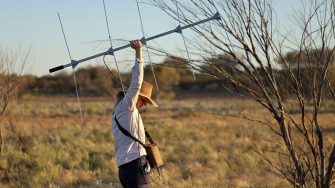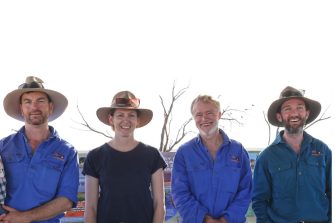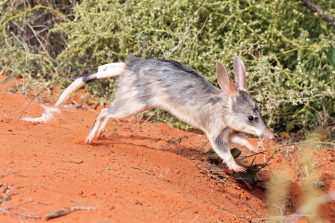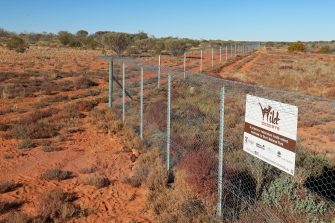
Our vision for the Wild Deserts project is
“To understand, restore and promote desert ecosystems through ecosystem manipulations, reintroductions and collaborative partnerships”.
Strategic research, delivered with scientific rigour, is ensuring ongoing successful delivery of project outcomes. We are implementing a Strategic Adaptive Management approach to link research and management (Kingsford et al. 2020). Wild Deserts will encourage and develop research partnerships and collaborations within the research themes of this project.
Current research projects
The Wild Deserts Ecological Health and Monitoring Framework identifies key hypotheses that are being tested through long-term ecological monitoring established at the project site and will contribute significantly to the research outputs of the project. These are also captured in our Strategic Adaptive Management approach.
Figure 1 from Kingsford et al. 2020: Strategic adaptive management planning—Restoring a desert ecosystem by managing introduced species and native herbivores and reintroducing mammals
In addition to this longer-term research, we currently have a number of targeted research-specific project collaborations adding value to our research goals:
-
Investigators: Brianna Coulter, PhD student UNSW; Dr Rebecca West, UNSW; Dr Katherine Moseby, UNSW; Professor Richard Kingsford, UNSW
Funding: internal funding, Holsworth Wildlife Research Endowment, Australian Wildlife Management Society
Timeline: 2019 - 2022
Summary: Wildlife reintroductions (releases of locally extinct species) into feral-free predator exclosures are increasingly being utilised in Australia, and around the world, to combat extinctions and ecosystem degradation. Despite this, there are few studies that experimentally manipulate reintroduction strategies to guide future management decisions, with most findings instead examined retrospectively, contributing to slow progression in the field of reintroduction biology. This PhD project aims to address key management questions that arise when planning reintroductions by using the greater bilby (Macrotis lagotis) as a model species. The study will examine whether founders sourced from a habitat comparable to the reintroduction environment have better establishment success. It will also investigate the impact reintroductions have on resident species in the receiving environment. In addition, optimal strategies for ensuring a genetically viable population will be assessed by conducting experimental reinforcements (adding animals to populations with extant conspecifics), collaborating with other sites conducting bilby reintroductions including Arid Recovery, SA and Mallee Cliffs National Park, NSW.
-
Investigators: Dr Rebecca West, UNSW; Dr Reece Pedler, UNSW; Dr Katherine Moseby, UNSW; Dr John Read, Ecological Horizons
Funding: internal
Timeline: 2020 - 2021
Summary: A reintroduction provides excellent opportunities for research, and the field of reintroduction biology actively encourages the use of experimental manipulations to further our understanding of best-practice reintroduction protocols. As few wild studies have been conducted on the crest-tailed mulgara, and this is the first translocation, there are numerous important opportunities for research into reintroduction protocols and basic biology/ecology of the species. Using radio-telemetry, trapping and camera traps, the team are examining the behavioural responses of mulgara post-release. An experimental release comparing dispersal distance following release into either temporary confinement pens or burrows is being used to determine whether hyper-dispersal behaviour can be reduced in this species.
-
Investigators: Dr Rebecca West, UNSW; Dr Reece Pedler, UNSW; Dr Katherine Moseby, UNSW; Dr John Read, Ecological Horizons; Roxane Francis, UNSW
Funding: internal
Timeline: 2018 - 2022
Summary: Between 2017 and 2018, Wild Deserts experienced the driest period on record. This has resulted in broadscale die off of long-lived perennial species. Drone technology may provide the opportunity to investigate the broadscale die off of perennial plants including determining susceptible species and extent of decline. However, the use of drone technology to measure die off is yet to be tested in arid areas. The team are using drone imagery and ground-truth data to determine whether drone image can be used to determine the extent of decline and potential recovery following drought-breaking rainfall.
-
Investigators: Dr Heloise Gibb, La Trobe University; Dr Nick Murphy, La Trobe University; Dr Katherine Moseby, UNSW; Dr Rebecca West, UNSW; Dr Bryony Horton, DPIE.
Funding: NSW Environmental Trust
Timeline: 2019 - 2022
Summary: Millions of dollars are spent annually building predator-proof reserves and conducting reintroductions for Australia's threatened mammals. However, we have little understanding of the impact of these reintroductions on ecosystems, particularly for the 'other 99%' of species (invertebrates and fungi). Understanding how species interact in food webs is critical for managing reintroduction. New reintroductions in NSW offer an opportunity to test how food webs change. Advances in genetic techniques allow the comprehensive investigation of trophic relationships, which will help us to better understand carrying capacities for reintroduced mammals, and the immense changes in Australian ecosystems following the demise of native mammals.
-
Investigators: Dr Reece Pedler, UNSW; Professor Richard Kingsford, UNSW; Dr Rebecca West, UNSW; Dr Katherine Moseby, UNSW; Dr John Read, Ecological Horizons
Funding: NSW Environmental Trust
Timeline: 2020 - 2030
Summary: Our ‘Beyond fences’ project is focused on returning threatened species to areas where low levels of feral predators are purposely retained, allowing these species populations to increase and improve their awareness of novel introduced predators, where their reintroductions will assist in restoring ecosystems. There is an increasingly strong emphasis on returning threatened species to fenced safe havens to tackle the major threat that introduced predators pose to their persistence, but this is not a long-term solution. Isolation from predators exacerbates prey naivety and can cause overpopulation. This project aims to use an innovative two-pronged approach through improving control of feral predators and increasing prey awareness to these predators to enable these species to live beyond fences and coexist with feral predators. Work by our team at other arid Australian sites has demonstrated we can do this. This work is critical, as it will never be possible to eliminate cats and foxes entirely from Australia’s mainland and there is a limit to the extent of fenced predator-free safe havens. Facilitating the restoration of our landscapes through the return of iconic locally extinct mammal species, such as bilbies and western quolls, would be a national achievement with international ramifications as well as providing considerable impetus for the restoration of Australia’s ecosystems. When our project is completed, we will have tested innovative technologies for sustainably controlling feral predators; identified thresholds of feral predator densities which allow different threatened species populations to coexist, improved the predator awareness of our native threatened species and communicated our work to scientists, practitioners, community and general public. Most importantly, we will have provided a framework for re-establishing threatened species beyond fencing, which can be adopted by conservation practitioners across Australia and beyond.
-
Investigators: Dr Rebecca West, UNSW; Dr Katherine Moseby, UNSW; Dr Tanya Leary, DPIE
Funding: internal
Timeline: 2019 - 2026
Summary: Australian arid zone ecosystems have changed significantly since European settlement. Threats such as introduced predators, grazing by rabbits, domestic stock and overabundant herbivores have caused local species extinctions, range contractions, and significant changes to vegetation structure. Microbats are an understudied arid zone vertebrate so their response to these threats is poorly understood. To combat the landscape degradation that has occurred since European settlement, fenced feral-proof reserves (‘safe havens’) are being constructed to reduce predation and grazing pressure. While these reserves often target conservation or ground-dwelling mammal reintroduction, they may provide significant benefits to microbat species by improving vegetation structure, increasing invertebrate abundance, increasing the quantity and quality of roost sites and reducing predator impacts. However, the benefits of fenced reserves to microbats have not been previously studied. This project will first determine the important habitat features used by microbats in desert environments including the use of artificial waterpoints, roosting sites and feeding grounds, using VHF tracking and ultrasonic surveys. Secondly, we will investigate how bat ecology is influenced by the removal of introduced predators and herbivores. Ultrasonic monitoring sites will be established inside and outside the fenced reserves so that bat responses can be compared. Invertebrate traps will be used to understand how herbivore removal and vegetation restoration influences food abundance. The use of the reserves by bats fitted with radiotransmitters will be compared with regional habitat use to determine if reserves provide important refuge or feeding habitat. The results will be used to determine how desert landscapes can be managed to secure the future of desert bats.
-
Investigators: Dr David Tucker, Queensland University of Technology; Professor Richard Kingsford, UNSW; Dr Reece Pedler, UNSW
Funding: ARC Linkage, Infrastructure, Equipment and Facilities grant,
Timeline: 2019 - 2024
Summary: The Australian Acoustic Observatory A20 project is a continental-scale acoustic sensor network recording for a five-year period across multiple Australian habitats (https://acousticobservatory.org/). Wild Deserts have installed four detectors within the project site.
Completed research projects
-
Investigators: Simon Gorta (honours student) UNSW; Dr Reece Pedler, UNSW; Professor Richard Kingsford, UNSW; Dr Corey Callaghan, UNSW; Dr John Read, UNSW
Funding: internal, Birdlife Australia
Timeline: 2019
Summary: Simon Gorta completed his honours project in 2019, receiving first class honours and the UNSW Ecology Medal. Simon’s project compared avian bird communities occupying contiguous desert ecosystems subjected to different drivers as a result of land management, and determined residency patterns in arid granivores during intense environmental conditions. This work is currently submitted for publication.
Publications
Pedler, R. D., West, R. S., Read, J. L., Moseby, K. E., Letnic, M., Keith, D. A., Leggett, K, Ryall, S.R. & Kingsford, R. T. (2018). Conservation challenges and benefits of multispecies reintroductions to a national park–a case study from New South Wales, Australia. Pacific Conservation Biology, 24, 397-408. https://doi.org/10.1071/PC17058
Kingsford R., West R., Pedler R., Keith D., Moseby K. E., Read J. L., Letnic M. and Ryall S. (2020) Strategic Adaptive Management planning - restoring a desert ecosystem by managing introduced species and native herbivores and reintroducing mammals. Conservation Science and Practice online early https://conbio.onlinelibrary.wiley.com/doi/10.1111/csp2.268
Pedler, R., Read, J. Moseby, K., Kingsford, R., Moseby, K. and West, R. (2020) Proactive management of kangaroos for conservation and ecosystem restoration – Wild Deserts, Sturt National Park, NSW. Ecological Management and Restoration (accepted)



